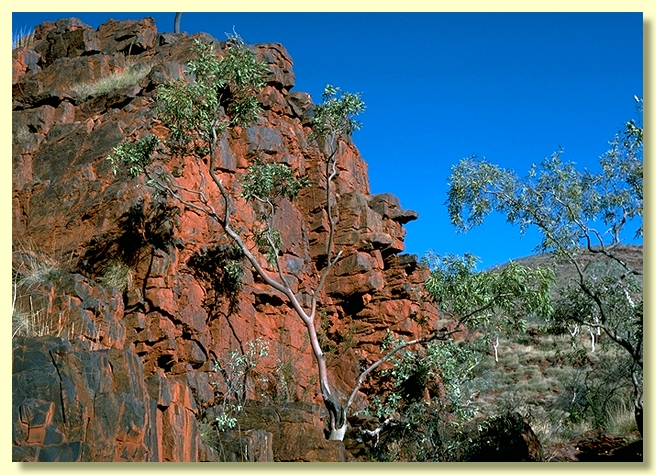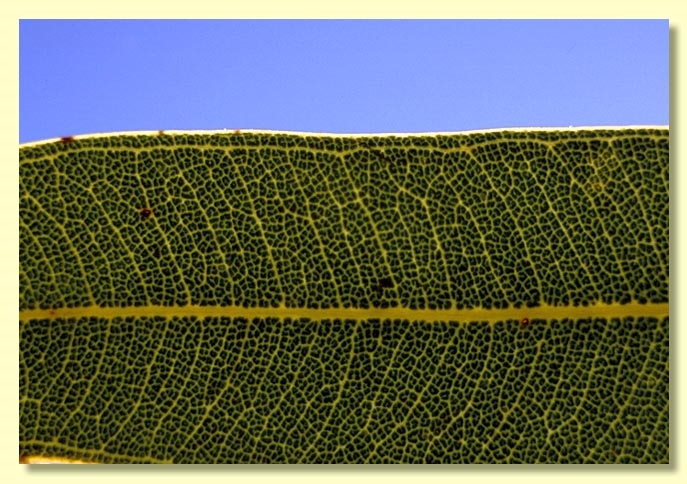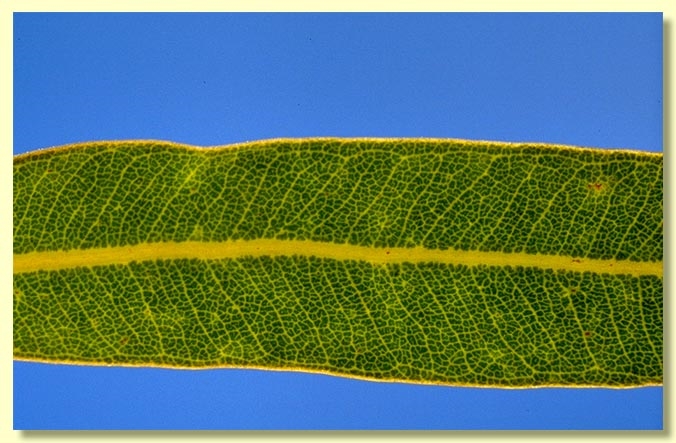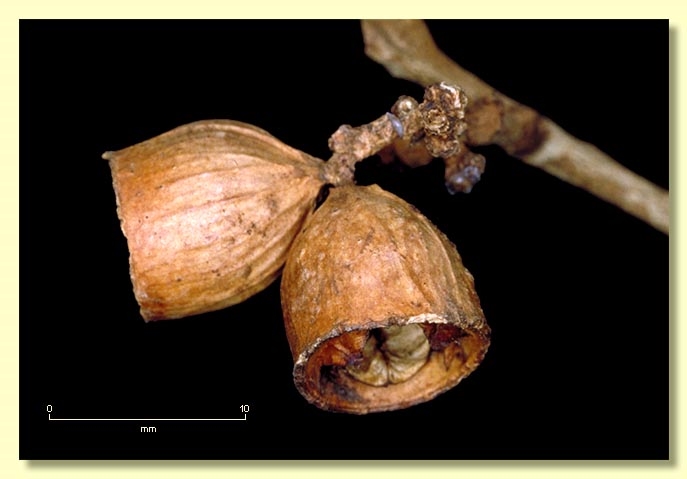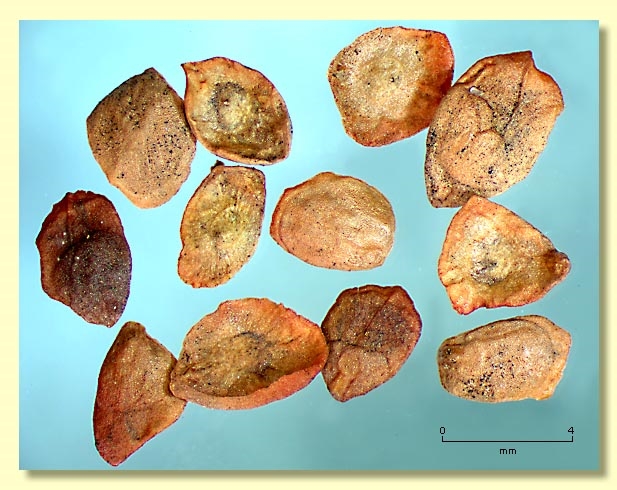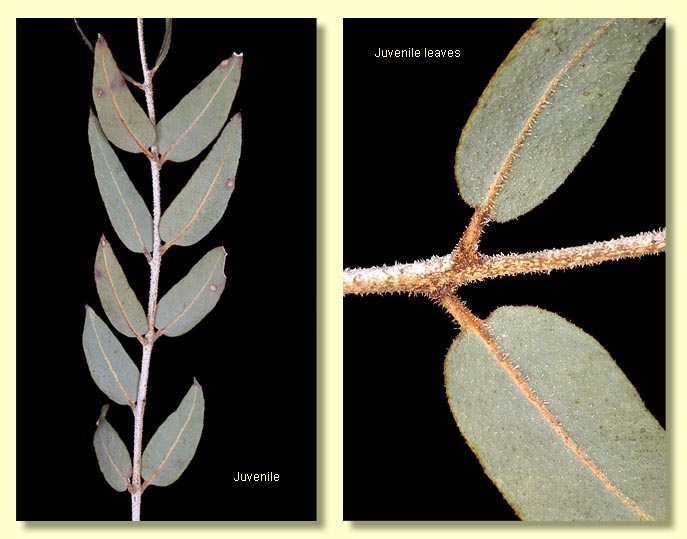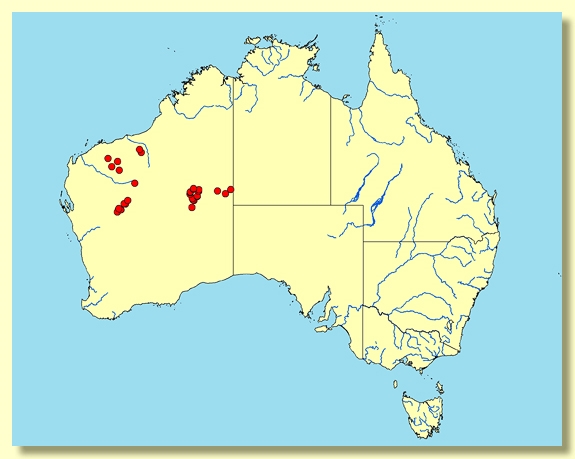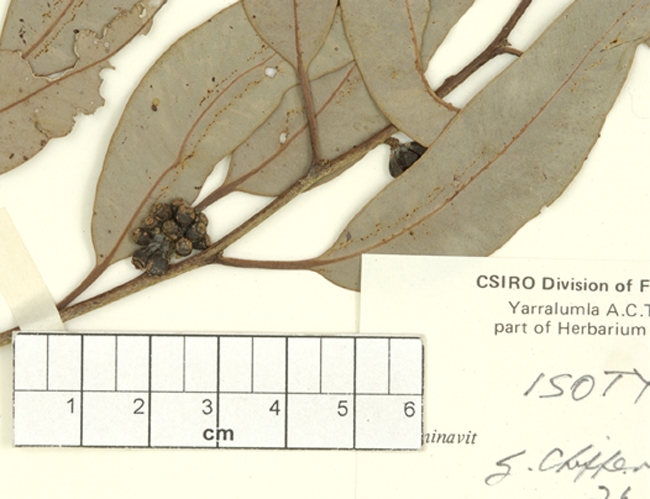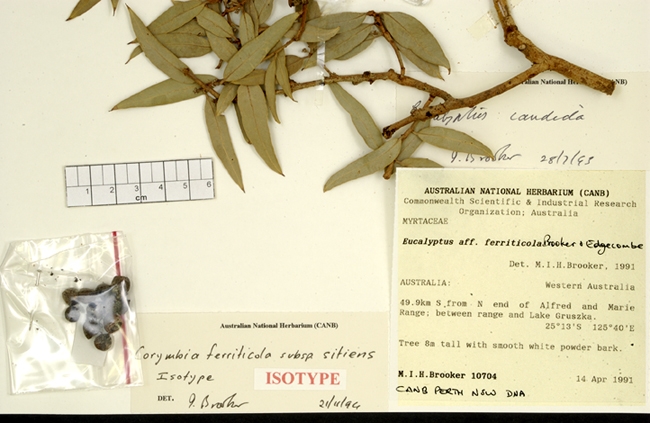Euclid - Online edition
Corymbia ferriticola
Corymbia | Blakearia
Bark usually smooth over the entire trunk, powdery, white to pink, weathering light brown to grey, sometimes with a small stocking of rough grey tessellated bark at the base.
Branchlets lacking oil glands in the pith; smooth.
Juvenile growth (coppice or field seedlings to 50 cm): stems rounded in cross-section, setose but becoming smooth with age; juvenile leaves opposite to sub-opposite and shortly petiolate, cordate to ovate to lanceolate, 3.5–8 cm long, 1.3–3.7 cm wide, base lobed to rounded, dull grey-green.
Adult leaves alternate, petiole 0.3–1.2 cm long; blade lanceolate, sometimes undulate, 4–10 cm long, 0.6–2.2 cm wide, base usually tapering to petiole, occasionally rounded, concolorous, dull to slightly glossy, grey-green to green, penniveined, densely to very densely reticulate, intramarginal vein present, oil glands abundant and island, but obscure.
Inflorescence axillary compound, condensed with peduncles short, 0–0.2 cm long, buds 7 per umbel, pedicels 0.2–0.5 cm long. Mature buds pyriform, 0.4–0.5 cm long, 0.3–0.4 cm wide, smooth (not scurfy), scar present (outer operculum shed during bud development), operculum flattened, stamens inflexed, anthers oblong, versatile, dorsifixed, dehiscing by longitudinal slits (non-confluent), style long, stigma tapered, locules usually 4, the ovules not arranged in distinct vertical rows on the placentae. Flowers whitish.
Fruit pedicellate (pedicels 0.1–0.5 cm long), truncate-ovoid to more or less cylindrical, sometimes campanulate, 0.6–1 cm long, 0.4–0.9 cm wide, thin-walled, disc vertically descending, valves 4, enclosed.
Seeds brown, round and flattened (saucer-shaped), usually with a small membranous flange around the edge, 3–5 mm long, surface smooth, sometimes slightly lacunose, hilum ventral.
Cultivated seedlings (measured at node 10): stems round in cross-section, setose throughout, leaves shortly petiolate, opposite, ovate, 4–11.5 cm long, 2.2–5 cm wide, dull yellow-green, apex acute, base rounded to tapering to the petiole, rarely lobed, usually setose on the under surface until at least node 17.
Flowering has beeen recorded in January and December.
A mallee or small straggly tree with the main distribution in the ironstone hills of the Pilbara region in Western Australia, but with sporadic occurrences further south towards Mount Augustus and Meekatharra and east to the Gibson Desert on Mount Beadell and near Lake Gruszka, and the northern fringe of the Great Victoria Desert in Western Australia. Corymbia ferriticola has smooth bark, often pink-brown to pale grey, but finally white and powdery. The juvenile leaves are ovate to lanceolate and scabrid. The adult leaves are grey-green to green, glabrous and lanceolate.
C. ferriticola is a distinctive species within its natural range, differing from the other common ghost gum species, C. candida, in having a crown of alternate leaves that are glabrous (smooth) with a tapering leaf base, never lobed, whilst C. candida has opposite leaves with lobed to rounded often stem-clasping leaf bases, and may be glabrous or quite scabrid. Both species have thin-walled fruit like all ghost gums. Within this zone there are four other white, smooth-barked eucalypts— E. camaldulensis subsp. refulgens, and subsp. arida along rivers, E. victrix in a variety of habitats and E. leucophloia subsp. leucophloia on ironstone hills—all easily distinguished from the ghost gums by the small fruit with valves easily visible (near rim level or exserted).
C. ferriticola subsp. sitiens, from remote stony to rocky country between Carnegie and the Alfred and Marie Range in Western Australia, was distinguished from subsp. ferriticola by having slightly narrower and thicker-textured adult leaves and narrower intermediate leaves. Collections are few and documentation of juvenile and intermediate growth phases poor. Consequently subsp. sitiens is not recognised as differing significantly by the authors of EUCLID.
MORE ABOUT CORYMBIA
MORE ABOUT GHOST GUMS



